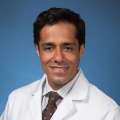An endoscopic procedure performed by UCLA Health’s Dr. Alireza Sedarat gave Lavario the ability to eat and drink normally again.
“I could not swallow for a year and a half,” recalls MaryAnn Levario.
Levario came to UCLA Health after a failed surgery for achalasia left her unable to eat or drink. “I had lost so much weight and muscle tone, my weight went down to 87 pounds. I was very sick and in so much pain.”
Achalasia is a disease that affects the nerve and muscle function of the esophagus and lower esophageal sphincter, resulting in difficulty swallowing. For Levario, achalasia first presented itself in symptoms similar to those of a heart attack.
“At work I experienced sharp chest pain – pain that radiated from my shoulder to my arm – and sweating followed by nausea,” she says. “The symptoms progressed to having prolonged amounts of fluids and food sit in my esophagus before passing into my stomach.”

Levario, in Central California, underwent a Heller myotomy, a surgical procedure intended to reduce the pressure on the tightened muscles of the lower esophageal sphincter and allow food and liquid to pass through into the stomach. It failed, however, to fix her condition.
“I became disabled to work. I was ill, confused of what was happening to my mind and body and health,” Levario says. “I looked online for a doctor who could help me. A video of Dr. Alireza Sedarat popped up, and he described achalasia. It was like he was speaking on exactly what I was going through.”
Dr. Sedarat is an interventional endoscopist and assistant clinical professor of medicine in the Vatche and Tamar Manoukian Division of Digestive Diseases at the David Geffen School of Medicine at UCLA.
“I met Dr. Sedarat in August of 2017,” Levario says. “He told me about the POEM procedure, which is a per-oral endoscopic myotomy. My insurance company thought the POEM procedure was experimental and they were only offering me a feeding tube. I was 44 years old. I said, ‘I'm too young to live on a feeding tube.’ Dr. Sedarat went as far as to call the director at my insurance company to explain the POEM procedure, how many he's done, and what he expected my outcome to be.”
Dr. Sedarat performed the POEM procedure on Levario on Oct. 4, 2017.
“When I woke up after surgery, the heaviness on my chest that made it difficult to breathe was gone,” Levario says. “I was able to swallow five ice chips, and I knew instantly that he had helped me. I was discharged the next afternoon.
“I'm here, I'm alive, I'm back to work, and living again because of Dr. Sedarat. Thank You Dr. Sedarat.”
Learn more about the clinical care available through the UCLA Robert G. Kardashian Center for Esophageal Health.

